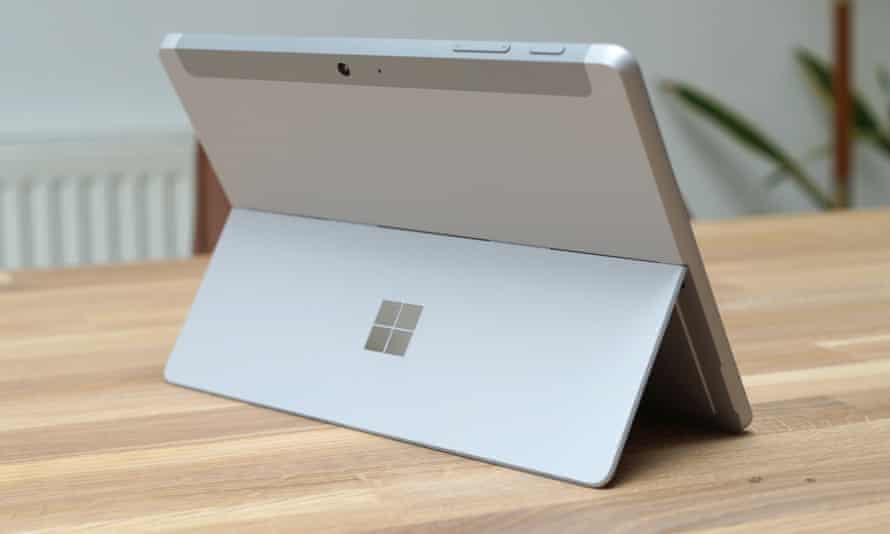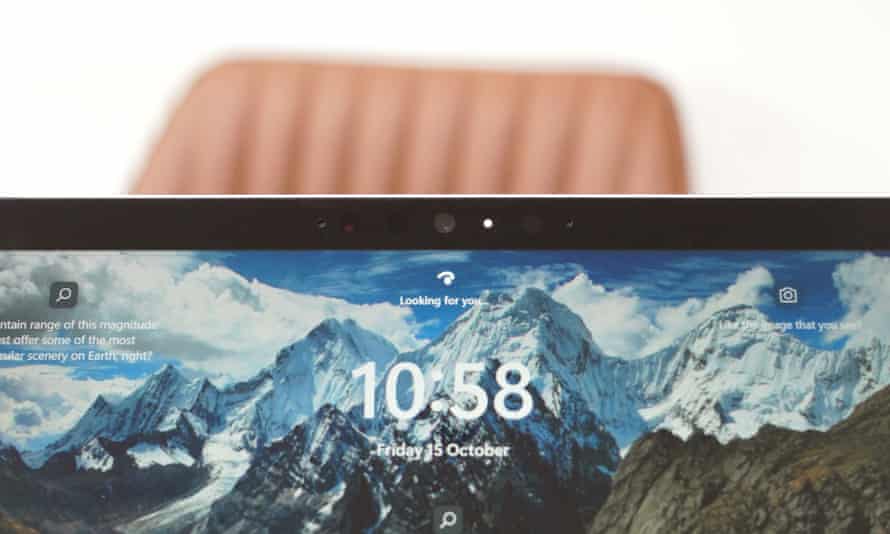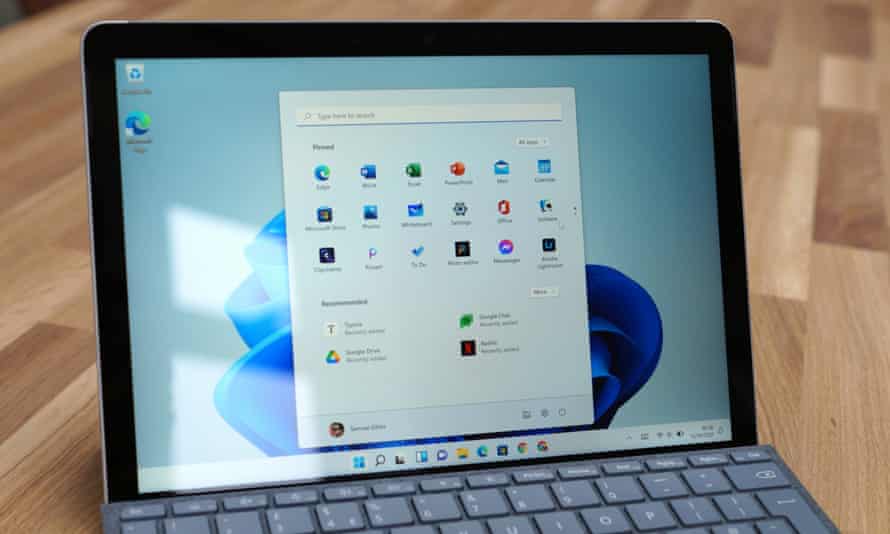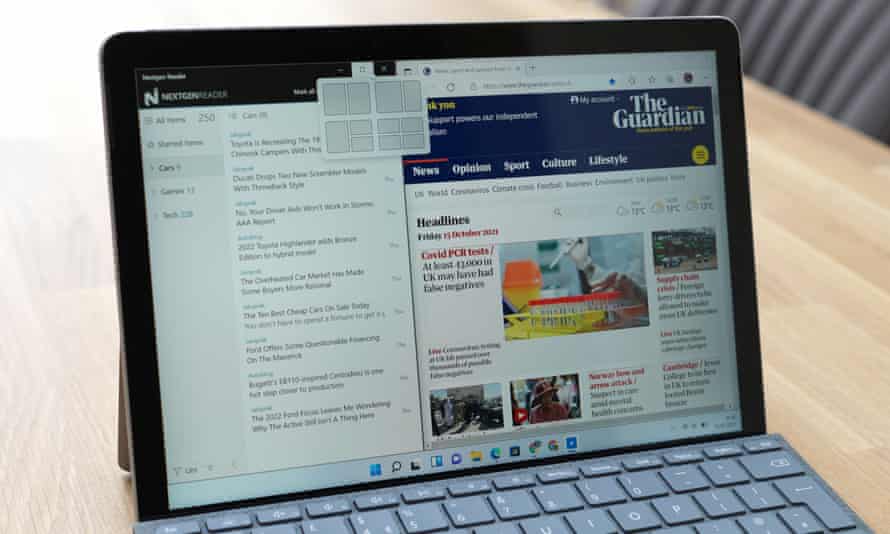Microsoft Surface Go 3 review: small Windows 11 tablet can’t keep up | Microsoft Surface
Microsoft’s smallest tablet PC gets Windows 11, newer chips and a small price cut but really needed more to make it worth the investment.
The Surface Go 3 has a tempting starting price of £369 ($399/A$629) – £30 less than its predecessor – but the cheapest model is saddled with a small amount of slow speed storage, making the mid-range 128GB model the real starting point, and it comes in at £499. Neither comes with the £99 keyboard, which is essential for such a machine. Still, it is Microsoft’s cheapest machine behind the £549 Surface Laptop Go.
Nothing on the outside has changed since last year’s Surface Go 2. It is the same size and weight, has the same good-looking 10.5in screen, magnesium body, great kickstand, stylus support and port selection. It is a small tablet that is easy to carry but still provides a full PC experience now running the new Windows 11.

Inside, the Go 3 has been upgraded. You have a choice of an Intel Pentium Gold 6500Y, which is much faster on paper than its predecessor, or a 10-generation Core i3 processor, which is about the same. Both are very much at the lower end of the market, based on older technology.
In testing, the top Go 3 model with a Core i3 chip felt pretty slow at times, occasionally hanging when attempting to do things such as installing apps or updates. On more than one occasion I ended up opening files twice because nothing had happened for long enough that I assumed I had missed on the first double-click attempt.
The tablet handles light duties such as word processing or browsing acceptably, and will manage photo editing and similar tasks with a bit of patience. But trying to do anything else while on a video call brought it to its knees.

Battery life is poor. Used for light work with recommended power settings and 70% screen brightness, it lasts only four hours. That’s with only a few tabs open in Chrome, using the Typora text editor and Evernote. Switching out Chrome for Microsoft’s Edge browser extended the battery by about an hour but that is still shorter than its predecessor.
Specifications
- Screen: 10.5in LCD 1920 x 1280 (220 PPI)
- Processor: dual-core Intel Pentium Gold 6500Y or 10th-gen Core i3
- RAM: 4 or 8GB
- Storage: 64GB eMMC or 128 SSD
- Graphics: Intel UHD 615
- Operating system: Windows 11 Home
- Camera: 8MP rear, 5MP front-facing, Windows Hello
- Connectivity: Wifi 6, Bluetooth 5, USB-C, Surface Connector, microSD, headphone socket
- Dimensions: 245 x 175 x 8.3mm
- Weight: 544g (without keyboard)
Sustainability

Microsoft does not provide an expected lifespan for the Surface Go 3’s battery. Batteries in similar devices typically maintain at least 80% of their original capacity after 500 full charge cycles. The tablet is generally repairable with an out-of-warranty service fee of £2547.10 and a battery replacement fee of £186.98.
Microsoft would not comment on the use of recycled materials in the machine. It operates recycling schemes for old machines, publishes a company-wide sustainability report and a breakdown of each product’s environmental impact.
Windows 11

Windows 11 is brand new, and it feels it. There are some rough edges that need smoothing out, such as the inconsistent dark mode with bright-white dialogue boxes, but overall it fits better on the Go 3’s small screen than Windows 10.
Much of the interface is more touch-friendly. The Start menu is centrally placed and much more condensed. The touch-screen keyboard is significantly improved and the new three-finger gestures for switching between apps or getting to the desktop are very welcome.
The modern quick settings panel that pops up from the task bar is useful as are the new snap layouts, which quickly tile two apps in various sizes side by side on the screen. You can’t, however, access the more varied sizes of the snap layout via touch, only with a pointer, and I found myself completely ignoring the new slide-out widgets pane as it did not really add enough to the experience to remind me it was there.
The changes to the Microsoft store are welcome, too, with apps from more developers now available, such as Disney+, making it the central place to get programs from and keep them updated automatically.
Price
The Surface Go 2 starts at £369 ($399/A$629) with an Intel Pentium 6500Y processor, 4GB of RAM and 64GB of eMMC storage or £499 ($529/$849) with 8GB of RAM and 128GB of faster SSD storage.
The version with the faster Intel Core i3 processor, 8GB of RAM and 128GB SSD costs £569/$629. The Surface Go Type Cover costs an additional £99.99 ($59.99/A$149.95).
For comparison, the Surface Pro 8 starts at £999, Apple’s iPad starts at £319 and the iPad Air starts at £579. Similarly sized Chromebooks start at about £250-£300.
Verdict
The Surface Go 3 looks nice, feels great and has a lot of potential as a mini tablet that offers a full Windows 11 PC experience.
But it is hindered by slow chips with inconsistent, laggy performance and a poor battery life. The competition has moved on significantly since the original Go and Go 2 launched but Microsoft has not kept up.
The cheapest Go 3 has only 64GB of slower eMMC storage, which is simply not enough for a good experience on Windows even if you store media and files on a microSD card. That makes the £499 it costs for a model with an adequate 128GB of SSD storage the real starting price. Buy it with the essential keyboard and the price goes up to £600.
While they may not be as compact or good looking as the Go 3, you can get much more capable Windows laptops for £600 from companies such as Lenovo, Acer, HP and others, while that much money buys a lot of iPad, Chromebook or Android tablet.
The Go 3, therefore, only makes sense if you simply must have a small Windows 11 tablet and are prepared to pay over the odds for it.
Pros: slim, light, good screen, great kickstand, decent speakers, USB-C, Windows Hello, full Windows 11 Home, microSD card reader, wifi 6, Bluetooth 5.
Cons: slow, inconsistent performance, short battery life, no USB-A ports, £100 keyboard essential but not included, Windows 11 not fully baked, comparatively expensive.


